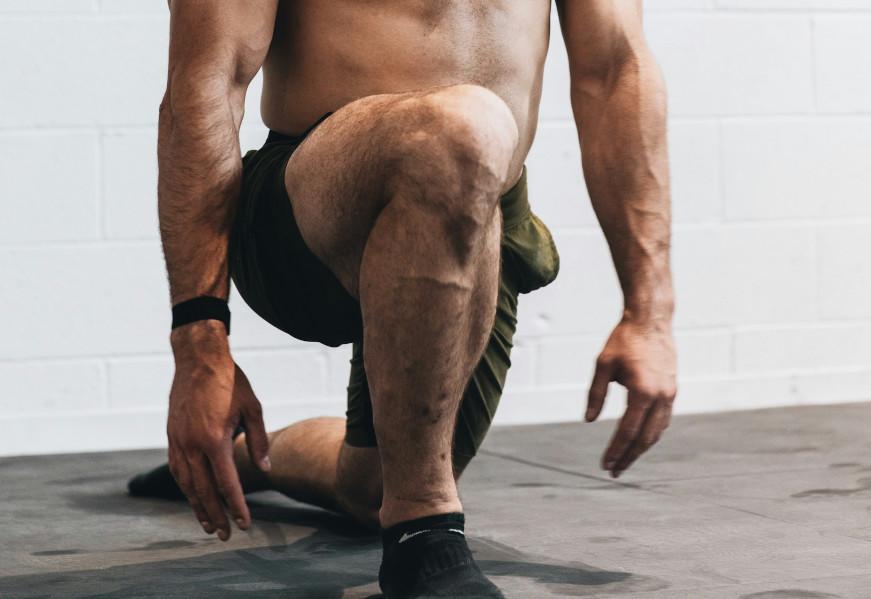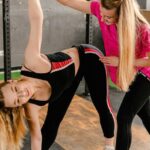Squatting is a fundamental movement that is not only prevalent in various forms of exercise but also in everyday life. As with any physical activity, a proper range of motion is vital to ensure safety and effectiveness. Incorporating mobility stretches into a workout routine enhances squat technique, promotes better muscle engagement, and reduces the risk of injury. These stretches target muscles and joints that are essential for a fluid and deep squat, such as the hips, thighs, and lower back.

Mobility exercises for squats can significantly improve performance. By focusing on hip mobility, athletes can attain a greater range of motion, allowing for a more profound and stronger squat. This is not limited to athletes alone; even casual gym-goers can benefit from these stretches. Methods like foam rolling and dynamic stretching warm up and loosen the muscles, preparing the body for the strain of squatting.
Given that squatting is a complex movement involving multiple muscle groups and joints, maintaining flexibility and mobility is crucial. A well-structured mobility routine helps in relieving tightness and enhancing the overall squat posture. This, in turn, contributes to achieving a full range of motion during the squat and better overall functionality during varied physical activities.
Fundamentals of Squat Mechanics
Squat mechanics are essential for both safety and effectiveness of the exercise. Proper form and mobility contribute to maximizing squat depth and strength.
Understanding Squat Form
The squat is a compound exercise that engages major muscle groups across the lower body and the core. When performing a squat, one should maintain a stance with feet shoulder-width apart and toes slightly pointed out. During the descent, hips move back and down while the chest remains upright, ensuring the spine is neutral. The depth of the squat should ideally be such that the hips descend below the knees.
Key components of squat form include:
- Stance: Feet shoulder-width apart
- Foot Alignment: Toes slightly pointed outwards
- Spine: Neutral throughout the movement
- Hip Movement: Back and down
- Chest Position: Upright to maintain balance
Importance of Mobility for Squats
Mobility, specifically in the hips, ankles, and thoracic spine, plays a pivotal role in achieving proper squat form. It enables a greater range of motion, allowing for a deeper squat without compensating form. Adequate mobility helps in:
- Preventing injury by reducing undue stress on the joints
- Enhancing overall squat performance by enabling proper activation of muscles
- Increasing squat depth to engage more muscles effectively
- Developing strength and power through a full range of motion
Exercises aiming at improving mobility for squats often include dynamic stretches such as:
- Ankle stretches: To allow the shins to move forward
- Hip openers: To enable the hips to descend lower
- Thoracic extensions: To maintain an upright chest
Regular incorporation of targeted mobility exercises will refine one’s squat technique and contribute to more robust lower body strength and power during workouts.
Key Mobility Stretches
Incorporating specific mobility stretches into your routine can improve squat form and strength, targeting key areas such as the hips, ankles, and thoracic spine.
Hip and Ankle Mobility Exercises
- Ankle Mobility:
- Dorsiflexion Stretch: Athletes can perform this by placing the toes against a wall with the heel on the ground and leaning forward until a stretch is felt in the ankle.
- Heel Sit-Backs: Sitting on the heels while the feet are flat on the ground stretches the ankles and can improve flexibility.
- Hip Mobility:
- Pigeon Pose: This yoga-inspired stretch targets the hip flexors and glutes and involves bending one leg in front of the body while extending the other behind.
- Lying Glute Stretch: Lie on your back, place one ankle on the opposite knee, and pull the thigh towards your chest to stretch the glutes.
Thoracic and Shoulder Mobility Drills
- Thoracic Mobility:
- Foam Roller Extension: Lying on a foam roller placed along the spine can help increase thoracic mobility by gently extending the back over the roller.
- Shoulder Mobility:
- Wall Slides: Stand with your back against a wall, place your arms in a “W” shape, and slowly slide them up to form a “Y”, which can increase shoulder mobility.
- Triceps Barbell Smash: Position a loaded barbell over your triceps and apply pressure, rolling back and forth to massage and stretch the muscle.
Dynamic Stretching Techniques
- Dynamic Stretches:
- Leg Swings: Holding onto a stable surface for balance, swing one leg forward and backward, increasing the range of motion with each swing.
- Squat-to-Stands: Grab the toes while in a bent-over position and then drop into a squat, driving the knees out with the elbows, and stand up, repeating this movement fluidly.
Mobility exercises and stretches not only enhance squat performance but also contribute to overall lower-body flexibility and injury prevention, making them essential for anyone looking to improve their squat technique.
Improving Squat Performance
Enhancing squat performance hinges on a structured approach that includes comprehensive warm-up routines, targeted stability exercises, and incorporating diverse squat variations. These elements are critical in bolstering squat mobility and reducing the risk of injury for athletes.
Warm-Up Routines for Squatting
To prime the muscles for squatting, athletes should engage in a dynamic warm-up routine consisting of movements that mimic the squatting motion. This regimen can begin with foam rolling to address any tight areas in the muscles, followed by dynamic stretching to increase blood flow and range of motion. Effective warm-up sequences might include bodyweight squats, walking lunges, and hip circles.
- Dynamic Stretching:
- Leg swings (front-to-back and side-to-side)
- Arm circles
- Pre-Squat Movements:
- Bodyweight squats: 2 sets of 10 reps
- Walking lunges: 2 sets of 8 reps each side
Stability and Core Strengthening
Core stability is crucial when performing squats, as it helps maintain proper posture and protects the spine. Athletes can enhance their core strength and stability by incorporating exercises like the plank, side plank, and bird-dogs into their routine. Additionally, performing squats with a pause at the bottom—squat holds—can increase stability and strength in the lower body.
- Core Strengthening Exercises:
- Plank: Hold for 30 seconds, 2-3 sets
- Side plank: Hold for 20 seconds on each side, 2-3 sets
Progression and Squat Variations
Exploring squat variations can keep training adaptable and prevent plateaus. Athletes should progressively increase the complexity and intensity of their squat exercises. Starting with bodyweight squats, they can transition into goblet squats with a light dumbbell and gradually implement back or front squats with a barbell as their mobility and strength improve.
- Squat Progression:
- Goblet squat: 3 sets of 8-10 reps with a light weight
- Front/Back barbell squat: Begin with a weight that allows for proper form, 3 sets of 5-8 reps
Enhancing Lower Body Mobility
Proper lower body mobility is crucial for optimal squat performance, reducing the risk of injury, and improving strength. This section offers targeted strategies and exercises aimed at increasing flexibility and range of motion in the hamstrings, calves, quads, and hip flexors.
Strategies for Hamstrings and Calves
The hamstrings and calves play a significant role in lower body mobility, particularly in the depth and stability of a squat. For the hamstrings:
- Static Stretches: Perform a seated or standing hamstring stretch, holding the position for 30 seconds to allow the muscle fibers to relax and lengthen.
- Dynamic Stretches: Incorporate walking straight-leg kicks, aiming to keep each leg straight as it rises to promote dynamic stretching of the hamstrings.
For the calves:
- Calf Stretch: Press the ball of the foot against a wall or curb with the heel on the ground, and lean forward, feeling a stretch in the calf muscle. Hold this position for 30 seconds before switching legs.
- Downward Dog: From a press up position, push back and elevate the hips, pressing the heels down to stretch both calves simultaneously.
Exercises for Hip Mobility and Flexors
Hip mobility is essential for achieving depth in squats and for overall lower body function. To increase hip mobility:
- Deep Goblet Squat Hold:
- Position: Stand with feet shoulder-width apart with a light dumbbell or kettlebell at chest level.
- Action: Squat deeply and use elbows to gently open hips, keeping the chest up and heels on the ground.
- Hold: Maintain for 30-60 seconds to enhance hip flexibility.
- Hip Flexor Stretch:
- Method: In a kneeling position, step one foot forward, and sink into the lunge, keeping the back straight and the rear knee on the ground.
- Action: Push the hips forward to stretch the hip flexors of the back leg.
- Duration: Hold for 30 seconds, then switch sides.
Incorporating these targeted exercises into one’s routine will support and enhance lower body mobility, facilitating more effective and safe squat performance.
Preventing and Managing Injuries
Effective injury prevention in squat exercises hinges on recognizing bodily imbalances and incorporating recovery techniques into one’s regimen.
Identifying and Addressing Imbalances
Imbalances in strength and flexibility can predispose individuals to injuries, especially in the lower back, knees, and hips. For instance, a disparity between the flexibility of the quadriceps and hamstrings may lead to knee injuries during squats. To identify such imbalances, one should monitor for any asymmetrical movements or discomfort during exercises. Once recognized, targeted stretching and strengthening exercises can help rectify these imbalances. Strengthening the glutes can also provide better stability for the knees, reducing the risk of injury.
- Key areas to monitor for imbalance:
- Lower back
- Knees
- Hips
- Strategies to address imbalance:
- Strengthening weaker muscle groups.
- Stretching tighter muscles to improve flexibility.
Incorporating Recovery Techniques
Recovery techniques are vital for managing and preventing injuries. Stretching post-workout aids in flexibility and can decrease the likelihood of lower back pain. Foam rolling and using a lacrosse ball target muscle knots and tightness, enhancing recovery and preventing muscle fatigue which often leads to imbalances. These techniques promote blood flow, helping in tissue repair and inflammation reduction.
- Effective Recovery Techniques:
- Stretching: Essential to maintain flexibility and prevent tight muscles.
- Foam rolling: Helps release muscle tightness and improve blood circulation.
- Lacrosse ball: Utilized for deep tissue massage, especially in hard-to-reach areas.
Special Considerations for Athletes
Adequate mobility is paramount for athletes to excel in strength, power, and performance. It ensures the proper execution of movements like front squats and overhead squats which are fundamental in sports like weightlifting and CrossFit.
Tailoring Mobility Routines to Sports
Each sport demands a unique set of movements and, by extension, a specialized mobility routine. A weightlifter, for instance, needs enhanced hip and ankle mobility to maintain posture during heavy front squats. Mobility Routines for Various Sports:
- Weightlifting: Focus on hip, ankle, and thoracic spine mobilization to aid in the clean and overhead squat.
- CrossFit: Incorporate a broad range of mobility exercises for both dynamic and static movements across various planes.
Athletes must identify the specific joints and muscles involved in their sport to target their mobility work effectively.
Improving Power and Explosiveness
Power and explosiveness are critical components for athletes who engage in rapid, high-intensity movements. To improve these attributes, mobility routines should include dynamic stretches that mimic the sport’s specific movements.
Exercises to Enhance Power:
- For front squats: Thorough warm-ups including dynamic lower body stretches to increase range of motion.
- To improve power in the clean: Mobility drills focused on the wrists, elbows, and shoulders for better turnover speed.
Each exercise should be performed with attention to detail, maintaining proper form to reinforce the movement patterns that contribute to power and explosiveness.
Optimizing Squat Mobility with Equipment

Equipment can be instrumental in enhancing squat mobility by providing targeted myofascial release and resistance. Implementing tools like foam rollers and resistance bands can specifically aid in developing the range of motion needed for effective barbell squats.
Using Foam Rollers and Balls
Foam rolling is a technique that involves using a cylindrical tube of compressed foam to perform self-myofascial release. The process helps in loosening tight muscles and improving blood flow, thus enhancing mobility for exercises such as the front squat.
- Quadriceps and Hip Flexors: Position the foam roller under the thighs and slowly roll from above the knees to the hips to target the quadriceps. Spending extra time on tight spots can further improve front squat mobility.
- Glutes: Sitting on the roller, cross one leg over the other and lean toward the crossed leg to target the gluteal muscles.
For more precise pressure, a lacrosse ball or a smaller mobility ball can be used to target the hard-to-reach areas around the hips and feet.
- Hip Flexors: Place the ball just below the hip bone and apply moderate pressure.
- Feet: Standing up, roll the bottom of the foot on the ball to relieve tension.
Barbells and Bands for Improved Range
Barbells and resistance bands can be used for dynamic mobility drills that prepare the body for the movement patterns of squat exercises.
Barbell Squats:
- Ankle Mobility: Place the barbell above the knees while in a squat position and shift weight side to side, focusing on keeping the heels down to improve ankle mobility.
Resistance Bands:
- Hip Muscles: Attach the band to a stable object and loop it around the thigh to perform lateral walks, which warm up and activate the hip abductors.
For Front Squat Mobility:
- Use a band to perform a front rack stretch by placing the hands inside the band, emulating the front squat grip, and applying outward pressure on the band to increase shoulder and wrist flexibility.
By incorporating these targeted mobility exercises and drills with the appropriate equipment, individuals can enhance the range of motion and stability needed for effective and safe squatting.








